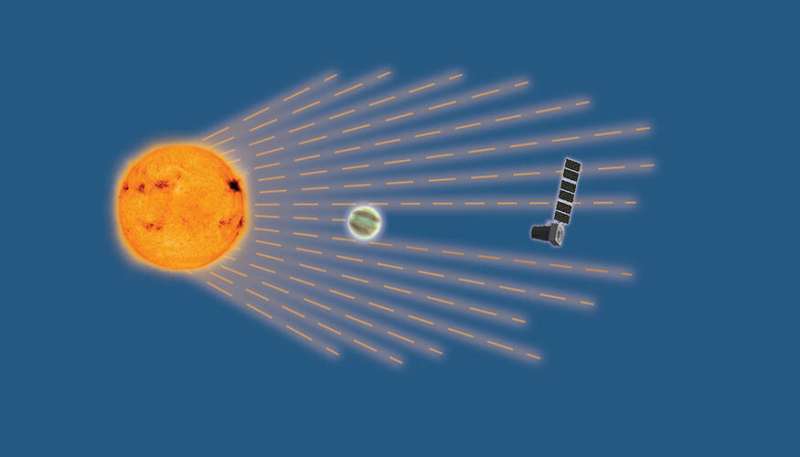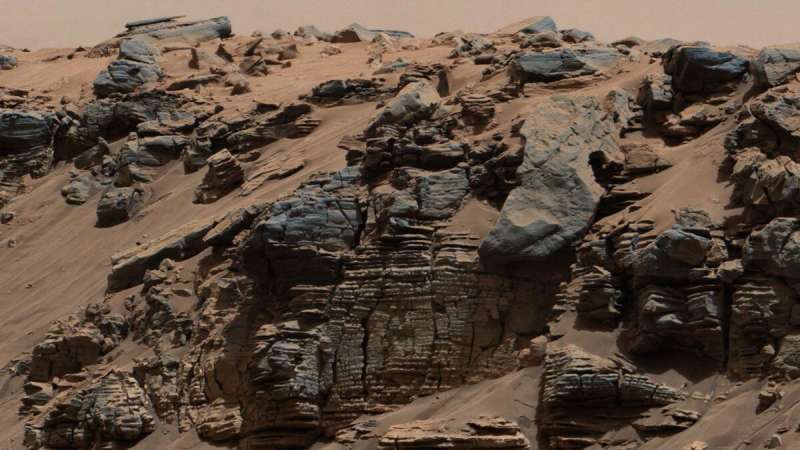
Copernical Team
New theory finds upcoming satellite mission will be able to detect more than expected
 The upcoming satellite experiment LiteBIRD is expected to probe the physics of the very early Universe if the primordial inflation happened at high energies. But now, a new paper in Physical Review Letters shows it can also test inflationary scenarios operating at lower energies.
Cosmologists believe that in its very early stages, the Universe underwent a very rapid expansion called "cosmi
The upcoming satellite experiment LiteBIRD is expected to probe the physics of the very early Universe if the primordial inflation happened at high energies. But now, a new paper in Physical Review Letters shows it can also test inflationary scenarios operating at lower energies.
Cosmologists believe that in its very early stages, the Universe underwent a very rapid expansion called "cosmi Increased space missions risk extraterrestrial contamination
 The days of the U.S.-Soviet Space Race are over, and the domain of space exploration is expanding daily to include more countries than ever before. With the advent of private companies such as Elon Musk's SpaceX, which aim to reduce the costs of space transportation, expeditions into our extraterrestrial surroundings are no longer limited to just two contenders.
Though it may seem like we
The days of the U.S.-Soviet Space Race are over, and the domain of space exploration is expanding daily to include more countries than ever before. With the advent of private companies such as Elon Musk's SpaceX, which aim to reduce the costs of space transportation, expeditions into our extraterrestrial surroundings are no longer limited to just two contenders.
Though it may seem like we Black hole at center of Milky Way unpredictable and chaotic
 An international team of researchers, led by postgraduate student Alexis Andres, has found that the black hole at the centre of our galaxy, Sagittarius A*, not only flares irregularly from day to day but also in the long term. The team analysed 15 years' worth of data to come to this conclusion. The research was initiated by Andres in 2019 when he was a summer student at the University of Amster
An international team of researchers, led by postgraduate student Alexis Andres, has found that the black hole at the centre of our galaxy, Sagittarius A*, not only flares irregularly from day to day but also in the long term. The team analysed 15 years' worth of data to come to this conclusion. The research was initiated by Andres in 2019 when he was a summer student at the University of Amster Oxygen ions in Jupiter's innermost radiation belts
 Planets like Earth, Jupiter, and Saturn with global magnetic fields of their own are surrounded by so-called radiation belts: Trapped in the magnetic field, fast moving charged particles such as electrons, protons, and heavier ions whiz around thus forming the invisible, torus-shaped radiation belts. With their high velocities reaching almost the speed of light, the particles can ionize other mo
Planets like Earth, Jupiter, and Saturn with global magnetic fields of their own are surrounded by so-called radiation belts: Trapped in the magnetic field, fast moving charged particles such as electrons, protons, and heavier ions whiz around thus forming the invisible, torus-shaped radiation belts. With their high velocities reaching almost the speed of light, the particles can ionize other mo Sol 3354: Tantalizingly Out of Reach
 Today Curiosity is doing a little bit of everything: some contact science, some targeted science, and a little driving. When we started planning this morning, we had a beautiful view of the small ledge in front of us, named "The Prow," which shows some amazing layering. We also can see some disturbances in the sand that may be sliding caused by our approach.
We, the rover planners, were bu
Today Curiosity is doing a little bit of everything: some contact science, some targeted science, and a little driving. When we started planning this morning, we had a beautiful view of the small ledge in front of us, named "The Prow," which shows some amazing layering. We also can see some disturbances in the sand that may be sliding caused by our approach.
We, the rover planners, were bu Widespread megaripple activity on Martian North Pole
 Megaripples, intermediate-scale bedforms caused by the action of the wind, have been studied extensively and thought to be largely inactive relics of past climates, save for a few exceptions. A new paper by Planetary Science Institute Research Scientist Matthew Chojnacki shows that abundant megaripple populations were identified across the north polar region of Mars and were found to be migratin
Megaripples, intermediate-scale bedforms caused by the action of the wind, have been studied extensively and thought to be largely inactive relics of past climates, save for a few exceptions. A new paper by Planetary Science Institute Research Scientist Matthew Chojnacki shows that abundant megaripple populations were identified across the north polar region of Mars and were found to be migratin Indian Space Agency tests cryogenic engine for its first-ever manned mission
 India's flagship human spaceflight mission, Gaganyaan, has completed the design and testing phases. The Indian Space Research Organisation (ISRO) plans to launch two uncrewed missions ahead of the final mission in 2023.
India's space exploration agency ISRO achieved a significant milestone with the successful long-duration cryogenic engine test for the Gaganyaan project on Wednesday.
India's flagship human spaceflight mission, Gaganyaan, has completed the design and testing phases. The Indian Space Research Organisation (ISRO) plans to launch two uncrewed missions ahead of the final mission in 2023.
India's space exploration agency ISRO achieved a significant milestone with the successful long-duration cryogenic engine test for the Gaganyaan project on Wednesday. Pandora mission to study stars and exoplanets continues toward flight

The Pandora mission, co-led by a national laboratory and a NASA flight center, has passed a crucial step on its path to study stars and planets outside our solar system, or exoplanets.
After a successful concept study report and system requirements review, NASA approved the mission to continue toward flight.
Machine learning algorithms help scientists explore Mars

NASA's Curiosity rover has been exploring the Red Planet's surface for nearly a decade, with its main mission being to determine whether Mars was once habitable. While the rover's investigations have indeed confirmed that Mars was once a watery world filled with potentially life-sustaining chemistry, there's still much to learn. Curiosity's mountains of data offer an opportunity to use machine learning algorithms to investigate the planet's surface in even more detail.
A new article in Earth and Space Science focuses on the data collected by Curiosity's Chemistry and Camera (ChemCam) instrument package. ChemCam combines two instruments: a laser-induced breakdown spectrometer (LIBS) and a remote micro-imager (RMI) for high-resolution imaging.
Mini monster black hole could hold clues to giant's growth
 The discovery of a supermassive black hole in a relatively small galaxy could help astronomers unravel the mystery surrounding how the very biggest black holes grow.
Researchers used NASA's Chandra X-ray Observatory to identify a black hole containing about 200,000 times the mass of the Sun buried in gas and dust in the galaxy Mrk 462.
Mrk 462 contains only several hundred million
The discovery of a supermassive black hole in a relatively small galaxy could help astronomers unravel the mystery surrounding how the very biggest black holes grow.
Researchers used NASA's Chandra X-ray Observatory to identify a black hole containing about 200,000 times the mass of the Sun buried in gas and dust in the galaxy Mrk 462.
Mrk 462 contains only several hundred million 